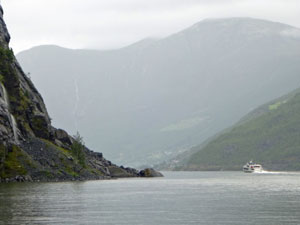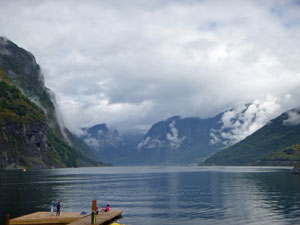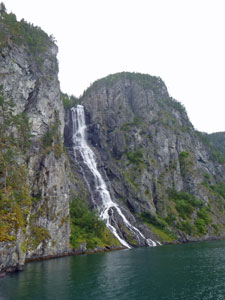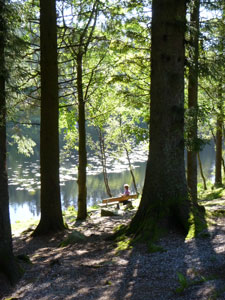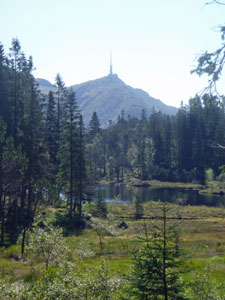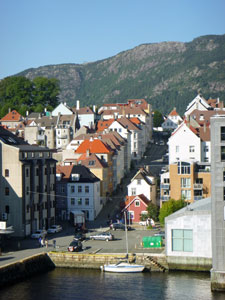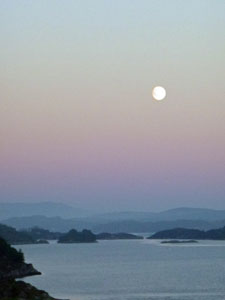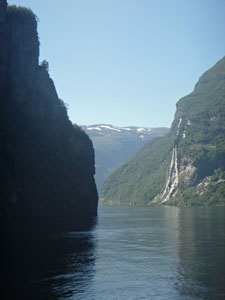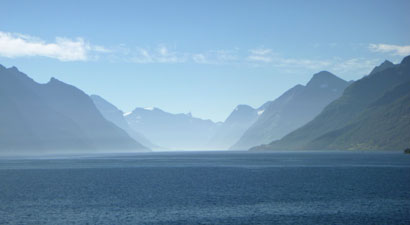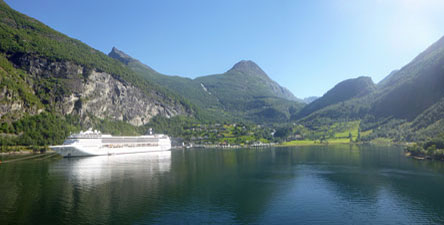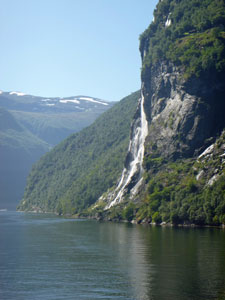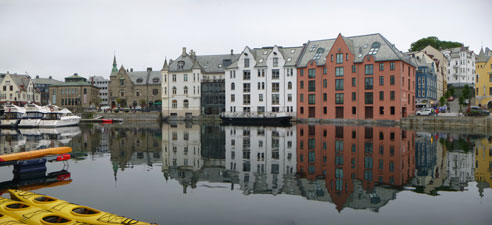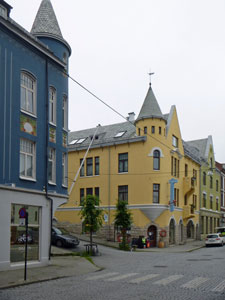| A Taste of the Norwegian Fiords |
Norway and fiords are synonymous - the west coast of the country is deeply indented with these long and deep tongues of the sea, ground out over millennia by glacier ice moving steadily down from the mountains. Our first taste of a fiord was the descent into Flåm by train, down the steep-walled valley to the village and tourist hub at the end of the Aurland Fiord. |
|||
 Scenes ..... |
 .... from the train ... |
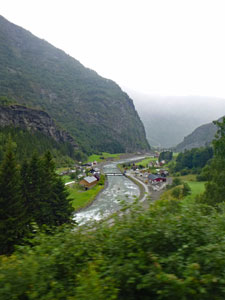 ..... trip ..... |
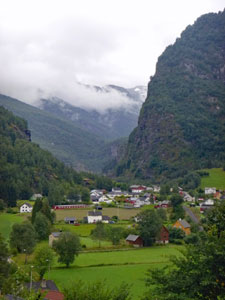 .... into Flåm |
|
During the time that we spent in Flåm, it was either raining, wreathed in misty cloud or both - a different view than the ones shown in postcards, but beautiful nonetheless as mists veiled the 1000m high rock walls backing the fiord and waterfalls cascaded down from the hidden tops. We quickly learnt, however, that fiordland in a Norwegian summer is a time of tourist crowds - gaggles of people following raised numbered paddles pouring off the big cruise ships that sail up the fiord, taking a ride on the Flåmsbana train and sailing off again. We escaped this by heading off into the mountain hinterland for a three day hike. |
|
After our walk, we explored the fiord system more by catching the express ferry from Flåm to Bergen. This 5-hour trip took us down the Sogne Fiord, the longest (205 km) and deepest (1300m) in the world. The day remained bleak and grey, but left us impressed with the power of ice, as we followed its length down to the sea, past several side fiords and through a mountainous landscape. |
||
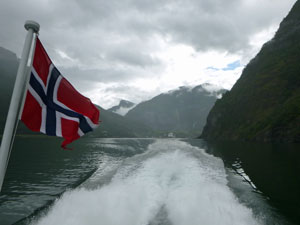 The fast ferry to Bergen |
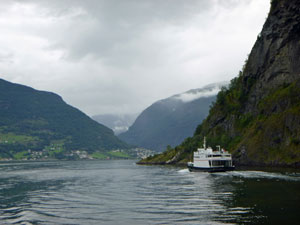 On the Sogne Fiord |
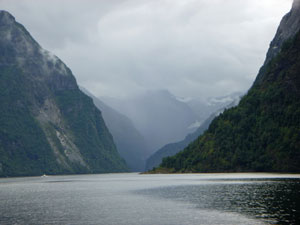 The entry to Naerøy Fiord |
|
On reaching the sea, we turned south to navigate the narrow channels between the mainland and many islands that hug the west coast to finally reach Bergen, Norway's second largest city. It was impressive to see the infrastructure along the way; modern bridges connecting islands and road tunnels connecting neighbouring valleys; Norway has made good use of its resource (oil) boom, unlike our own country's government, which p---ed it all away on tax cuts for big business and the wealthy few (no more soap-box). |
|
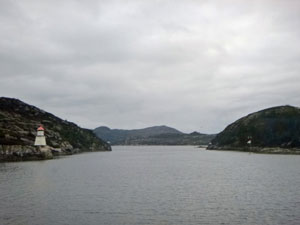 Sailing between the low coastal islets |
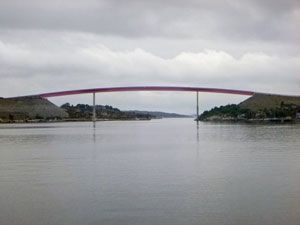 An impressive bridge between mainland and island |
|
We effectively had two days to explore Bergen, this tourist mecca of Fiordland - along with thousands of other tourists pouring in by train, plane and cruise ship - I suspect we outnumbered the locals. My dislike for "classic" tourism was rapidly being reinforced as we jostled with the crowds and ducked to avoid selfie-stick injuries. I wondered whether these anti-social devices might be a good topic for a PhD thesis - "Selfie-sticks and the rise of narcisso-tourism" (that title should attract a few research grants). |
 The colourful old buildings of Brygge |
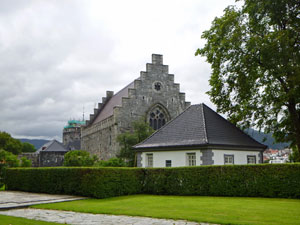 Church in Bergen Fort |
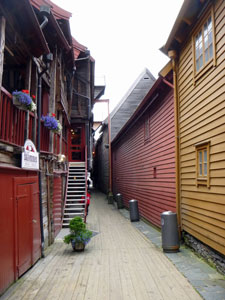 Heritage-listed 17th century houses |
Anyway, we "did" the usual things - a visit to the old heritage-listed wooden buildings of Brygge, ate fish soup at the harbourside fish markets, wandered the wide pedestrian malls and lovely gardens to see if we could spot a local and drank a couple of $15 beers at an outdoor cafe in the sunshine. Yes, sunshine! - for the first time in several days the sun was back. |
||
The next day, we took advantage of the fine weather to try and escape the crowds by heading up to Fløyen, one of the seven hills of Bergen. It took a while, queueing for an hour to ride to the top on the funicular railway, before piling out to try and find a gap in the line of people posing on the viewpoint railing for the classic panoramic photo of Bergen. |
|
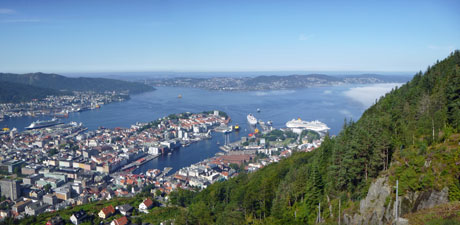 The classic panorama of Bergen from Fløyen |
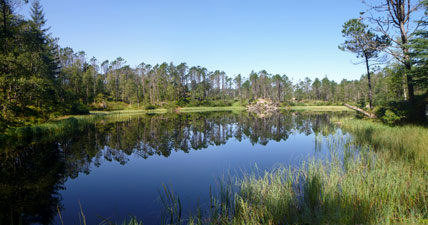 A lake in the forest of Fløyen |
Then we quickly headed inland and upwards on one of the many paths that lead into a lovely mossy coniferous forest dotted with picturesque lakes. The crowd quickly thinned out, as most people take their photo, eat something at the kiosk and then queue to go down the funicular. The forest of Fløyen became our peaceful haven. |
|
|
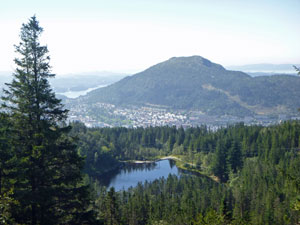 Fløyen - forest, mountain ... |
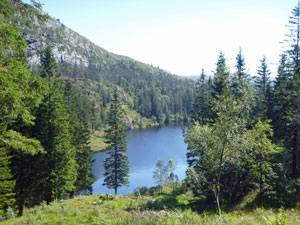 .... and lakes |
|
Finally, we headed back to the city, descending via a series of long switch back paths in the dappled shade of the broadleaf trees that lined the slope. Thus ended our visit to Bergen - we were heading to the port and the next stage of our taste of the fiords. |
||
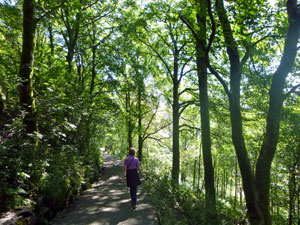 Shady descent from Fløyen |
 Looking down on to the buildings of Bergen |
|
One of the most popular ways to see the coast and fiords of Norway is to take a cruise on one of the Hurtigruten boats. This company began as a transporter of freight between the towns and cities of the west coast that took the odd passenger, but, during tourist season, has evolved into a cruise line that carries the odd bit of freight. Most people boarding at Bergen would stay on board for the six day trip to Kerkenes in the far north. We decided to travel Hurtigruten, but, as we were only going as far as Ålesund, we would only have 24 hours on board - enough to give us a taste of the cruising life. |
After our day on Fløyen, we headed to the harbour and boarded MS Midnatsol a couple of hours before departure - time to enjoy a beer on the aft deck looking out over the mountain-backed Bergen skyline. Then with a loud blast of its horn, Midnatsol sailed off at 8pm, which gave a couple of hours of daylight to enjoy the passage through the low-lying islands, islets, skerries and rocks that dot the coast-line north of Bergen. |
|
|
 Sunset over the Norwegian Coast |
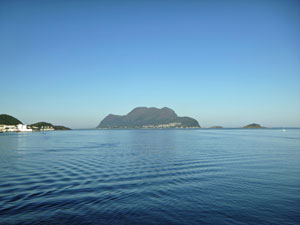 The islands of Western Norway |
|
The next morning we woke as the ship was docking in Ålesund - three pallets of freight off, one pallet on, watched by several hundred passengers. The changed nature of Hurtigruten's business model was evident. We stayed on board this time, as, for the next four hours the Midnatsol was heading deep into the fiords.
With clear blue skies, it was a chance to see them up close in all their glory - firstly, eastwards up the broad Stor Fiord, with glimpses of distant snow-topped peaks, then south into Sunnylv Fiord, where abandoned farms perched high up the slopes on tiny ledges of green pasture, and finally into Geiranger Fiord. |
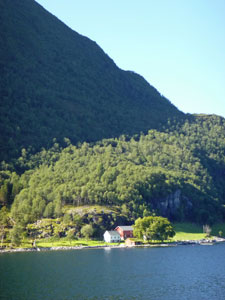 Farmhouse on Stor Fiord
|
This heritage listed fiord was even narrower and steeper-walled, with waterfalls tumbling from the heights. After reaching the end of the fiord and Geiranger village, we dropped off some disembarking passengers and freight, turned around and did it all again in reverse. It was just as spectacular the second time around.
|
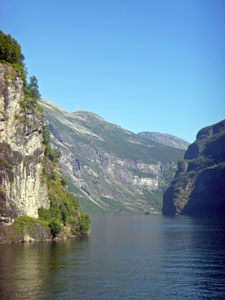 Turning into Sunnylv Fiord
|
|
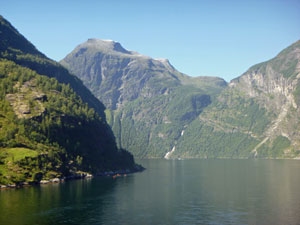 |
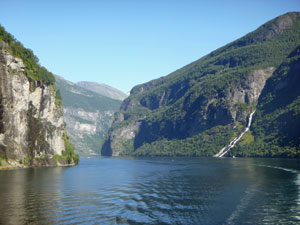 Sailing through Geiranger Fiord |
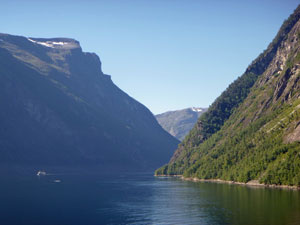 |
Finally, we docked at Ålesund for the second time and this time we disembarked. I had enjoyed my 24 hours on the cruise ship, but that was enough - sitting around letting the landscape slide by is fine for a day, but any longer and boredom would have started setting in - there is a need to be more actively involved with the landscape and walking satisfies this. As well, being on a cruise ship is a bit like being in a luxury sheep pen - too many people in too little space. There is no escape from the steady drone of people talking, the upwind smokers and the buffeting at the buffet bar.
|
|
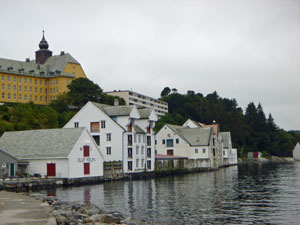 The old pre-Art Nouveau buildings |
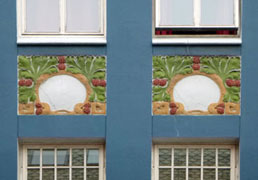 |
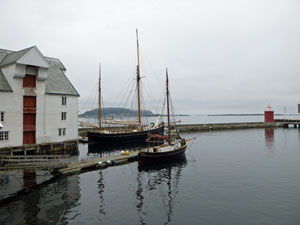 Breakwater and lighthouse at Ålesund |
A few years back, Ålesund was voted the most beautiful town in Norway - famed for its early 1900s Art Nouveau buildings, constructed after the town was almost completely razed by a fire in 1904. From our comfortable apartment base, we wandered its streets, so peaceful after the crowds of Bergen, and took in the sights from Aksla, the knoll behind the city. |
||
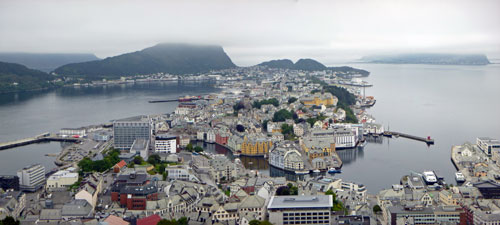 View over Ålesund from Aksla |
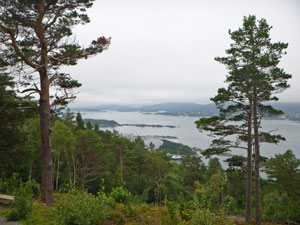 Looking down onto the fiord from the ridge of Aksla |
It had been a pleasant end to our "taste of the fiords" adventure. But now it was time to get back into the mountains and do some trekking - Jotunheimen was calling. |
|









